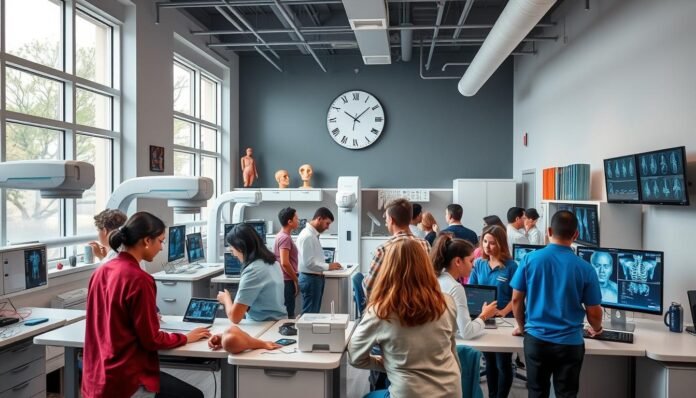Radiology tech school length varies. There are several paths to becoming a skilled radiology professional.
This guide explores different program lengths. We’ll look at factors influencing duration and career prospects.
A vibrant classroom setting filled with radiology equipment, students engaged in hands-on learning, anatomical models displayed, a large clock on the wall symbolizing time passing, bright natural light streaming through windows, modern technology integrated into the environment, diverse group of focused students working together, radiology charts and images on screens, educational atmosphere.
Radiology technology offers diverse career opportunities. It’s for those interested in healthcare and advanced imaging tech.
We’ll explore various radiology tech school programs. This will help you choose the best path for your goals.
Understanding Radiology Technology Programs
Radiology technology is key in healthcare. It uses advanced imaging to help with medical diagnostics.
Radiologic technologists support doctors in identifying medical conditions. They use special equipment to diagnose and treat patients.
Becoming a radiologic technologist requires extensive training. Programs teach both theory and practical skills.
Students learn to use X-rays, CT scans, and MRI machines. They also focus on patient care and radiation safety.
Training covers medical diagnostics, anatomy, and imaging techniques. Graduates can work in hospitals, clinics, and imaging centres.
Radiology technology programs are vital for healthcare. They prepare professionals to improve patient outcomes through advanced imaging.
Different Types of Radiology Programs
Radiology technicians have several education options, including associate’s, bachelor’s, and certificate programs.
An associate degree in radiology takes two years to complete. It teaches basic radiographic principles and techniques.
These programs often include hands-on clinical training. Students learn skills for entry-level jobs in hospitals and clinics.
A bachelor’s degree in radiology technology is a four-year program. It covers advanced imaging methods and patient care.
Graduates may find better job opportunities. They can also advance their careers more easily.
Certificate programs in radiology last about one year. They’re great for healthcare workers wanting to specialize.
These programs focus on skills for radiologic technicians. Students learn specific knowledge needed for the job.
All programs cover important subjects. These include anatomy, radiation physics, and image analysis.
The goal is to prepare students for patient care. They also learn to contribute to diagnostic imaging.
Typical Length of Radiology Tech Programs
Radiology technician programs vary in length. An associate degree in radiology takes about 2 years to complete.
A bachelor’s degree in radiology typically requires 4 years of study, while certificate programs can be completed in about 1 year.
Associate degree programs teach medical imaging basics. Students learn anatomy, patient care, and radiation safety.
These programs include hands-on clinical rotations. Students gain practical experience in healthcare settings.
A bachelor’s degree timeline offers more in-depth education. It covers advanced imaging techniques and leadership skills.
Research schools’ specific requirements and program lengths. This helps you make an informed decision about your education.
Choose a program that fits your goals and timeline, and you’ll be on your way to becoming a radiology technician.
Factors Influencing Program Length
Radiology tech programs can vary in length. The course load and program type affect how long it takes.
Programs with more advanced topics often last longer. The type of degree also impacts the duration.
Clinical training hours play a big role. More hands-on training means a longer program.
Accreditation standards can affect program length, too. Regional rules may also impact how long it takes.
Research these factors before choosing a program. Look at course load and clinical training needs.
This will help you pick the best path. You can then reach your career goals in radiology.
Online vs. On-Campus Programs
Radiology students can choose between online and on-campus education. Both options have unique benefits for future radiology technicians.
Online programs offer flexible distance learning. Students can complete coursework at their own pace and schedule.
This suits those balancing studies with work or personal commitments. Program length may vary due to self-paced learning.
On-campus education provides a structured, immersive experience. Students follow set schedules and complete in-person clinical rotations.
This leads to more consistent program lengths. Hands-on training and face-to-face interactions benefit some learners.
The best choice depends on individual needs and goals. Students should pick the format that fits their lifestyle.
This ensures a smooth and successful radiology tech school experience.

Accreditation and Its Impact on Duration
Accreditation is vital for radiology technology programs. It ensures high-quality education and adherence to industry standards.
Accredited schools provide essential knowledge and skills. They prepare students for success in the radiology field.
Accreditation can affect program duration. Accredited programs often have more comprehensive curricula and clinical rotations.
These programs may take longer to complete. However, they offer better preparation for the workforce.
Choose programs accredited by organizations like the JRCERT. Accredited programs provide a strong educational foundation.
They also improve job prospects and earning potential. Prioritizing accreditation ensures alignment with industry standards.
Clinical Rotations and Their Time Commitment
Clinical rotations are a key part of radiology tech education. Students work with pros to learn real-world skills in various settings.
These rotations make up a big chunk of radiology programs. They give students hands-on training in different procedures.
Most associate’s degree programs include 900 to 1,500 hours of clinical work, which can last 24 to 40 weeks and prepare students for their future jobs.
Students rotate through hospitals, imaging centres, and outpatient clinics. This helps them build a wide range of skills and experience.
Part-Time vs. Full-Time Study
Radiology technology students can choose between part-time and full-time programs. Each option has its benefits for different types of learners.
Part-time radiology programs offer flexibility. They usually take 2 to 3 years to complete.
These programs let students balance studies with work or family. The workload is more gradual and manageable.
Full-time study options are more intensive and faster. These programs can be finished in 1 to 2 years.
Students can focus fully on their studies. This approach suits those without major outside commitments.
Your choice depends on your situation and goals. Both options provide flexible learning opportunities.
Accelerated Radiology Programs
Accelerated radiology programs offer a quick path to becoming a radiologic technologist. These programs provide intensive study, allowing students to finish their education faster.
Accelerated radiology programs can be completed in 12-18 months. This is much shorter than the 2-3 years for standard associate’s degree programs.
These fast-track options have a tough curriculum with a heavy course load. Students follow an intensive study approach to learn everything quickly.
These programs can be hard but offer benefits for motivated students. Graduates can start working sooner and gain valuable hands-on experience.
Due to their intense nature, accelerated programs may not suit everyone. Students must balance demanding coursework, clinical rotations, and personal commitments.
Before choosing an accelerated program, consider your learning style and time. Also, consider whether you can handle the high level of commitment required.
Preparing for Radiology Tech School
Getting ready for radiology tech school takes careful planning. Students should know the program’s requirements before applying.
Many programs require courses in anatomy, physiology, and medical terms. Some also require good grades or test scores.
A cluttered study space filled with radiology textbooks, anatomy models, and a laptop displaying medical imaging software, sunlight streaming through a window, emphasizing a sense of focus and preparation for radiology school.
Job shadowing or volunteering in healthcare can help. This gives real-world experience and confirms interest in the field.
Good preparation helps students succeed in their program. It sets them up to become skilled radiology technicians.
Career Prospects After Radiology Tech School
Radiology tech grads have many job options in healthcare. The field is growing fast, with 9% more jobs expected soon.
Techs can work in hospitals, clinics, imaging centres, and vet offices, where they can also handle animals.
Grads often start as general radiologic technologists. They can focus on X-rays, CT scans, or MRIs.
With more training, they can become radiation therapists or mammographers. Some may work on heart imaging as cardiovascular technologists.
Many techs move up to manage imaging departments. They often teach and guide newer staff.
Some get special certifications for better jobs. Others teach in radiology tech schools.
FAQ
How long does it take to complete a radiology tech program?
An associate degree program usually takes 2 years. A bachelor’s degree program typically lasts 4 years.
What factors affect the duration of a radiology tech program?
The type of degree and program structure impact duration. Clinical training hours and full-time or part-time status also affect length.
Are there any accelerated radiology tech programs available?
Yes, some schools offer faster programs lasting 12-18 months. These intensive courses help students earn degrees quickly.
How important are clinical rotations for radiology tech students?
Clinical rotations are vital for hands-on experience in healthcare settings. Training can range from hundreds to over a thousand hours.
Can I study radiology tech online?
Online and hybrid radiology tech programs are available. They offer more flexibility but may require in-person clinical training.
What are the typical admission requirements for radiology tech programs?
A high school diploma or GED is usually needed. Science and math courses, minimum GPA, and entrance exams may be required.
What are the career prospects for radiology technologists after completing their education?
The job outlook is good, with 9% growth expected. Radiology techs can work in hospitals, clinics, and imaging centres.
You may also read: How Much Does a Pharmacy Tech Make – Salary Guide 2024
